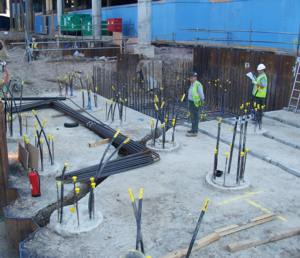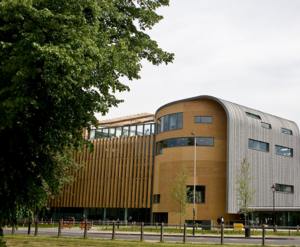Lambeth College advances the science of sustainable design

Fossil fuels play no part in servicing a new building at Lambeth College. Instead the project advances the application of ground-source heat pumps to a new dimension by combining the ground loops with the structural piles.
There are no boilers and no chillers in the new sixth-form centre of Lambeth College, which looks out over London’s Clapham Common. Its comprehensive facilities include a rectangular main teaching block and a performing-arts centre, both of which are five storeys high. A 4-storey atrium links these two blocks, with an artists’ garden on the roof.
Instead the energy strategy is based on a geothermal system to provide heating via ground-source heat pumps in a ground-floor plant room and cooling by exploiting the steady low temperatures at depth. The system can deliver 302 kW of heating and 460 kW of cooling.
Energy is drawn from the ground, or rejected to it, through water loops incorporated into the structural piles.
It was to meet the aspirations of a forward-looking client for a low-energy building with a substantial part of the energy provided from renewable sources that it was decided to use the piles as part of a ground-source heat-pump system. It is expected that renewable energy will meet 24% of total requirements. Water is circulated through pipes in the piles to take advantage of the constant temperatures to provide heating, via heat pumps, in winter and cooling in summer. There are 145 piles in the London clay, each 22.5 m long, and each pile has two water loops.
This Geothermal piling system was designed by Aecom, formerly Faber Maunsell, and developed with Geothermal International. It can meet the entire space-heating demand, virtually all the cooling requirement and 60% of the requirement for domestic hot water.
Thermal mass also helps to achieve a low-energy solution. The structure has considerable thermal mass and exposed soffits that can be cooled overnight in the summer to absorb heat during the day. The thermal mass is provided by a concrete flat-slab construction that is post-tensioned.
As designed, the project was expected to have 52% lower CO2 emissions than the notional targets of Part L of the Building Regulations.
Typically in an innovative low-energy building that is designed to maximise the potential of renewable energy, close attention has been given to factors such as orientation, glazing and internal exposed thermal mass to minimise the need for furthering tempering of the indoor environment. There is also extensive passive shading.
The orientation of the building maximises north light, with teaching spaces located on the north facade. Stairs and external louvres are carefully positioned to limit solar gains and prevent overheating.
Heat gains are also minimised by protecting the south and south-western facades from overheating with brick cladding and windows only where needed.
There is an atrium at the heart of the building, providing views of Clapham Common and bringing daylight into all areas.
The energy for further heating and cooling of the building is drawn from the ground by a closed-loop geothermal system and its temperature boosted by heat pumps for space heating.

Cooling requirements are generally met with free cooling using ambient air. The low-level induction ventilation system can achieve comfortable conditions using outside air below 18°C; this arrangement covers 85% of the year with the help of fabric cooling overnight.
When the outside air is warmer than 18°C, supply air is cooled by the geothermal system, the only energy required being for the water pumps.
Only for about 5% of the year when it is very hot outside and the buildings are fully occupied will the further support of a dry cooler be required. This fan-powered unit simply reduces the temperature of the return water from the cooling system by rejecting it to atmosphere before returning it to the ground.
The location of the college on the a noisy road to the south of Clapham Common required the building to be acoustically sealed to comply with Building Bulletin 93. To deliver fresh air and achieve the required standards of indoor air quality, there is a demand-led intelligent ventilation system, which also provides heating and cooling to all spaces through the floor void.
For space heating and domestic hot water, energy from the ground is upgraded by four heat pumps that can each deliver up to 120 kW of heat with a predicted COP of 5.5. Hot water is supplied to the VAV heating system at a low temperature of 50°C and a return of 40°C.
There is a separate heat pump to preheat domestic hot water, which is stored in a calorifier and distributed at 50°C. Chlorine dioxide is used to treat the water to minimise the risk of legionella. Electric immersion heaters are used to periodically raise the temperature of the stored water to 65°C to pasteurise it.
A significant benefit of integrating the ground loops into the structural piles is that all the geothermal energy is drawn from within the building’s footprint, an important consideration in towns and cities.
Because there was a lack of knowledge about the effect of heating and cooling on a piled system, this building is the subject of a collection of published research papers examining the subject to expand knowledge in the industry.
Geothermal piles can provide significant CO2 savings for low-rise buildings, and Aecom has looked at this approach for other projects. Buildings of one or two storeys could typically be expected to achieve CO2 savings of about 50%. The CO2 savings for buildings up to four storeys would be about 20%, falling off to about 10% for taller buildings when only piled geothermal solutions are applied.
This new building at Lambeth College achieves significant reductions in carbon emissions compared with the latest requirements of the Building Regulations and is also considerably better than what is expected in the 2010 Building Regulations. It is still, though, some distance short of zero carbon. However, with the cooling and heating strategies both designed not to use fossil fuels and to minimise electricity consumption, the building’s carbon emissions can be expected to become even lower as the mains electricity supply is decarbonised.








